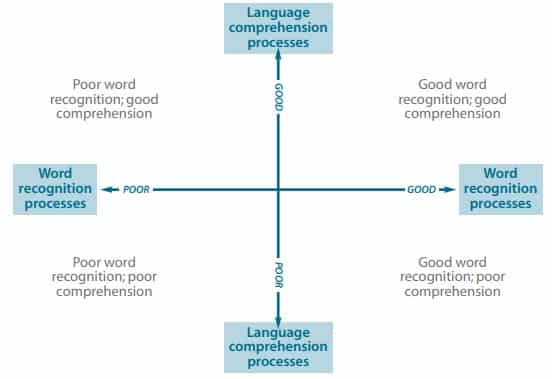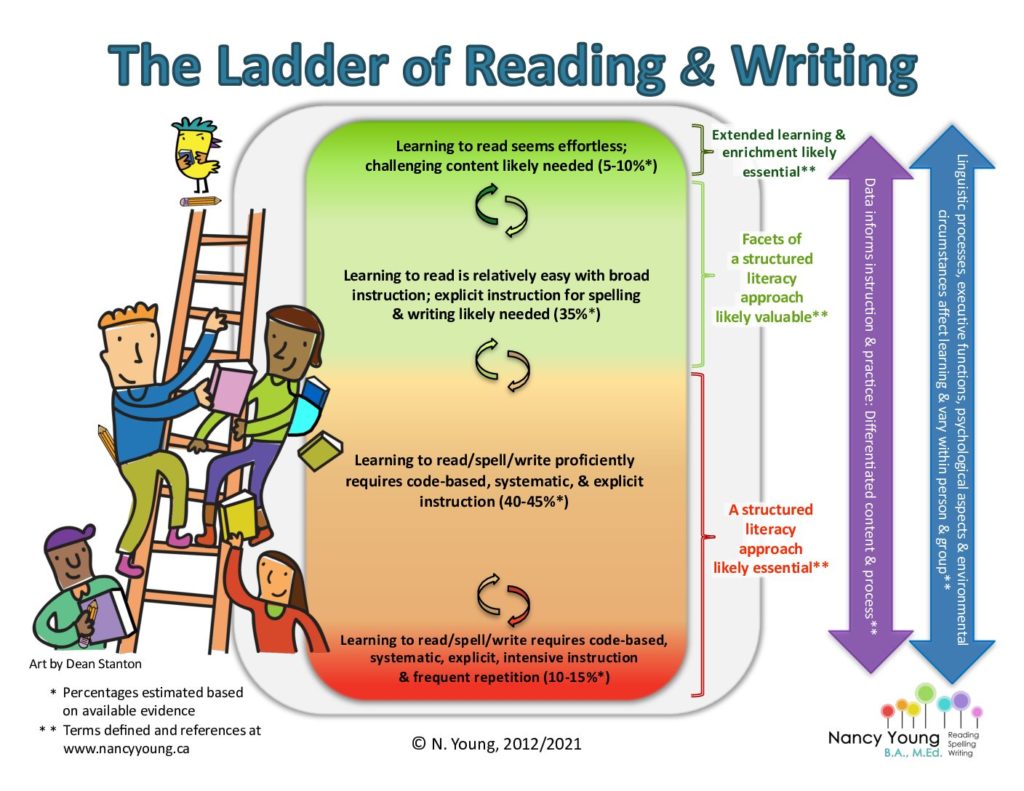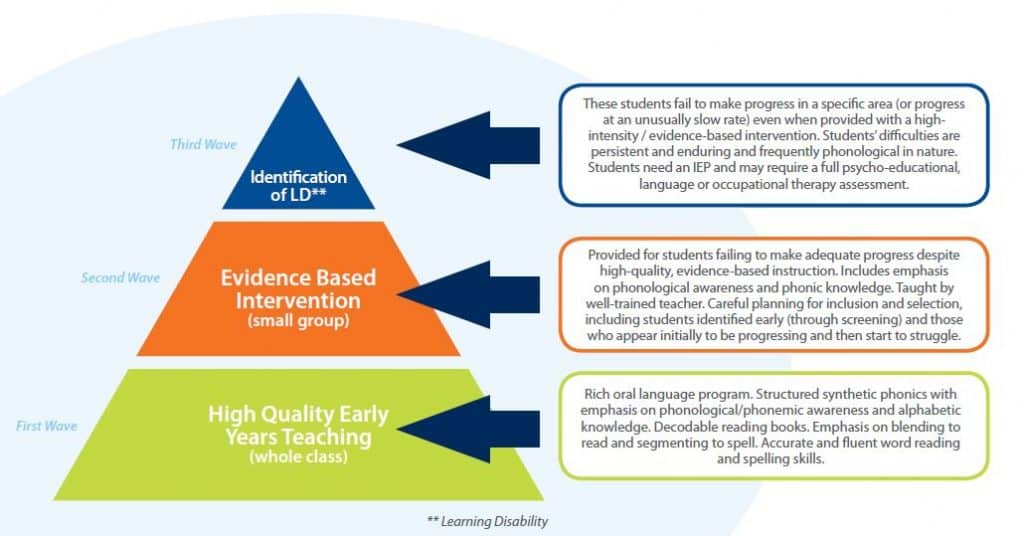Some children struggle to learn to read for a variety of environmental and biological reasons. However, effective interventions are not dependent on knowing the primary cause of the difficulty — they are instead based on the nature of the difficulty. That is, they attend to the aspects or sub-skills of the reading process with which the student is having difficulty.
The Simple View of Reading
The Simple View of Reading (SVR) has been validated and extended by many studies since it was put forward by Gough and Tunmer (1986). It says that reading comprehension is the product of word recognition and language comprehension, and provides us with a useful framework for preventing and treating reading difficulties.
The most efficient form of word recognition involves a combination of phonic decoding and orthographic mapping. These skills are dependent upon strong letter-sound knowledge, phonological blending, and phonemic proficiency. We address those on this page. Language comprehension is a complex ability reliant on vocabulary knowledge, background knowledge, working memory, and knowledge of syntax, among others, and are addressed in the sections of this website on vocabulary and comprehension.
Independent Review of the Teaching of Early Reading, Rose (2006)
The SVR can help us to prevent reading difficulties if we pay attention to the development of word level reading and comprehension skills in at-risk learners.
At risk learners may be defined as:
- students from socioeconomically disadvantaged backgrounds,
- students who have learning difficulties such as dyslexia or language disorder,
- students who have English as an additional language.
Structured and explicit teaching of reading is beneficial for all children and essential for some
Structured literacy refers to a teaching approach that prepares students to decode in a systematic, cumulative and diagnostic manner. Structured literacy approaches teach phonology, grapheme-phoneme correspondences, syllables, morphology, and syntax.
Systematic and explicit approaches are essential for the majority of students and advantageous for the students who are not at risk of reading difficulties. They are especially important for children who are predisposed to reading and language difficulties, whether as a result of an impoverished home environment or inherited/biological factors, or both.
Response to intervention
While it is not be possible for schools to change a child’s home environment, or influence socioeconomic and genetic factors, schools are responsible for the quality of the learning environment.
Schools can provide the best possible learning environment for all students by using programs that are supported by reliable research evidence and delivering them in the context of a Response to Intervention (RTI) model. An RTI model has three tiers or ‘waves’ that support all students.
Tier 1 – High quality whole class/school instruction for the K-3 grades, including a rich oral language program combined with a structured, systematic and explicit phonics program that is consistently applied across the early grades.
Tier 2 – This tier is aimed at students who are not meeting benchmarks for their grade and have reading and writing levels below average. Strategies used in Tier 2 instruction are very similar to Tier 1, however their implementation is more intensive (small group) and targeted and gives more opportunity for practice.
Tier 3 – Students are placed in this level when they have not made sufficient progress despite having small group instruction as part of Tier 2. These students require in-depth assessments of their reading and spelling skills to determine their greatest areas of need and should have intensive targeted interventions using evidence-based programs. Students receiving Tier 3 intervention will require an individualised education plan (IEP) with regular assessment and monitoring.
The RTI model is summarised by the National Centre on RTI website:
“With RTI, schools identify students at risk for poor learning outcomes, monitor student progress, provide evidence-based interventions, and adjust the intensity and nature of those interventions depending on the student’s responsiveness.”
Response to intervention model. Source: Understanding Learning Difficulties: A practical guide (AUSPELD, 2014).
Phonics should be a key feature of RTI for children with difficulties at the word level
At risk learners may have difficulties appreciating the individual sound-spelling relationships, and may develop problems with any of the component skills necessary for accurate and fluent word reading such as phonological awareness, phonemic awareness and phonics. They may also have difficulty with language or comprehension skills. For these students, careful systematic instruction in letter-sound correspondences (phonics), segmenting and blending, along with advanced phonemic awareness skills (isolation, deletion and manipulation) is essential.
Decodable texts are a critical part of reading instruction because they provide the opportunity for beginning and struggling readers to practice reading connected text with taught grapheme-phoneme correspondences. When attempting to read uncontrolled text with words containing grapheme-phoneme correspondences that are unfamiliar, struggling readers are forced to guess words. Guessing is a highly unreliable strategy and even good readers find that contextual guessing is accurate on only one of four or five occasions (Stanovich, 1990).
Decodable texts should not be the only text in the beginning readers’ literacy diet. At-risk readers should continue to be exposed to language-rich texts in the classroom. Such texts should be read to them by their teacher until such time as they have the knowledge to read these texts for themselves. At-risk or struggling readers may require longer periods of practice with decodable text in order to build their confidence and competence in reading texts independently.
There is a belief that phonics does not work for struggling readers because some students have difficulty acquiring phonic knowledge. The most common causes of failure to acquire phonic knowledge are poor phonological processes and insufficient practice. Poor phonological processing delays the development of letter-sound knowledge and can lead to difficulty with blending which decreases the efficiency of phonic decoding. Poor phonic decoding interferes with orthographic mapping and fast word recognition.
Low Rapid Automatic Naming (RAN) is also a factor in word reading fluency. Low RAN makes it difficult for children to automatically recall letter-sounds and apply them in word reading. Poor phonological processing and low RAN are best addressed with more systematic and explicit phonics instruction, rather than less.



